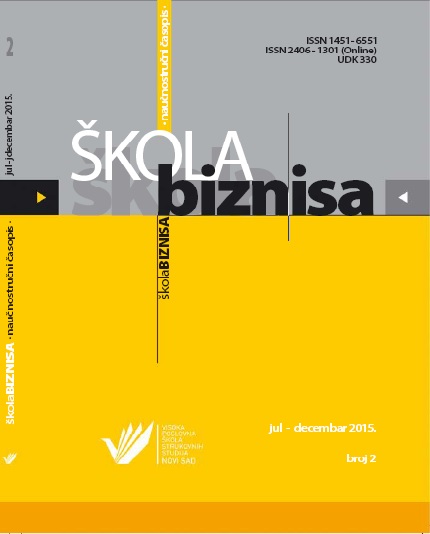TECHNOLOGY LEADERS OF COMPUTER AND WEB 2.0 USAGE IN HIGHER EDUCATION: CASE STUDY
Abstract
Development of ICT usage and open concepts brought new learning paradigm of knowledge creation to the higher education. Main role in this new concept in infrastructure aspect is reserved for web 2.0. The authors of this paper present the case study with the experience of students in the higher education institution. In the first part of the study authors analyze the data collected from the students related to Internet access and Internet activities from them. This research was conducted using questionnaires based on indicators defined by Eurostat and data authors found in the students’ projects created by web 2.0 tools. The main part and purpose of this paper is to analyze how students in Serbia are using web 2.0 tools in their research work. Authors found trends in web 2.0 tools usage and the most popular technologies, concluding that web 2.0 tools are speeding the process of projects development.
References
Ahrens, A., Wen, M. L. Y., Huang, Y. H., Zascerinska, J., & Bassus, O. (2010). A Comparative Study of the Relationship between Social Dimension of Web 2.0 Technologies and E-Learning: Students' View in Germany and Taiwan. Innovation and Entrepreneurship and its Implications in Engineering and Business Education. Philippines: Manila.
Amersdorffer, D., Bauhuber, F., & Oellrich, J. (2012). The economic and cultural aspects of the social web: Implications for the tourism industry. Journal of Vacation Marketing. 18(3), 175-184.
Anderson, P. (2010). What is Web 2.0? Ideas, technologies and implications for education. Retrieved from http://www.scribd.com/doc/300024/What-is-web-20-Ideas-technologies-and-implications-Paul-Anderson.
Brusilovsky, P., & Peylo, C. (2003). Adaptive and Intelligent Web-based Educational Systems, International Journal of Artificial Intelligence in Education, 13(2-4), 159-172.
Casey, G., & Evans, T. (2011). Designing for Learning: Online Social Networks as a Classroom Environment. The International Review of Research in Open and Distance Learning, 12(7), 1-26.
Chi, H. (2012). Who Knows? Searching for Expertise on the Social Web. Communications of the ACM, 55(4), 110-110.
Chou, H. W., Chang, K. C., & Lin, Y. H. (2013). Investigating Facebook and Google usage in Taiwan's college students. International Journal of Services Technology & Management, 19(4-6), 201-218.
Devedžić, V. (2004). Education and the Semantic Web. International Journal of Artificial Intelligence in Education, 14(2), 165-191.
Fieseler, C., & Fleck, M. (2013). The Pursuit of Empowerment through Social Media: Structural Social Capital Dynamics in CSR-Blogging. Journal of Business Ethics, 118(4), 759-775.
European Commission. Eurostat – Information Society Data Collection. Retrieved from http://epp.eurostat.ec.europa.eu/portal/page/portal/information_society/introduction/
Greenhow, C. (2007). What Teacher Education Needs to Know about Web 2.0: Preparing New Teachers in the 21st Century. In: R. Carlsen et al. (eds.), Proceedings of Society for Information Technology & Teacher Education International Conference 2007 (pp. 1989-1992).
Hew, K. F., & Cheung, W. S. (2013). Use of Web 2.0 Technologies in K-12 and Higher Education: The Search for Evidence-Based Practice. Educational Research Review, 9, 47-64.
Jošanov, B., Marošan, Z., & Tomić, R. (2010). ICT as a Facilitator for e-Learning 2.0 Implementation. In: Proceedings from IASK Teaching and Learning 2010 International Conference (pp. 734-738), Seville.
McLean, R., Richards, B. H., & Wardman I. (2007). The effect of Web 2.0 on the future of medical practice and education: Darwikinian evolution or folksonomic revolution? Medical Journal of Australia, 187(3), 174-177.
O’Reilly, T. (2007). What is Social web: Design Patterns and Business Models for the Next Generation of Software. International Journal of Digital Economic, 65, 17-37.
Paavola, S., Lipponen, L., & Hakkarainen, H. (2004). Models of Innovative Knowledge Communities and Three Metaphors of Learning. Review of Educational Research, 74(4), 557-576.
Peštek, A., Kadić-Maglajlić, S., & Nožica, M. (2012). Implications of Web 2.0 Usage in Higher Education. International Journal of Management Cases, 14(1), 3-12.
Pritchett, C. C., Wohleb, E. C., & Pritchett, C. G. (2013). Educators' Perceived Importance of Web 2.0 Technology Applications. TechTrends: Linking Research and Practice to Improve Learning, 57(2), 33-38.
Sangeeta Namdev, D. (2012). ICT and Web Technology Based Innovations in Education Sector. Turkish Online Journal of Distance Education, 13(4), 256-268.
Sezen Balcikanli, G. (2012). Social Networking in Physical Education: Undergraduate Students' Views on Ning. Turkish Online Journal of Distance Education, 13(2), 277-290.
Sfard, A. (1998). On Two Metaphors for Learning and the Dangers of Choosing Just One. Educational Researcher, 27(2), 4-13.
Surčulija, J., Pavlović, B., & Jovanović Padejski, Đ. (2011). Mapping Digital Media: Serbia: A Report of Open Society Foundation. Belgrade: Open Society Media Program.
Thackeray, R., Neiger, B. L., Hanson, C. L., & McKenzie, J. F. (2008). Enhancing Promotional Strategies Within Social Marketing Programs: Use of Web 2.0 Social Media. Health Promotion Practice, 9(4), 338-343.
Turban, E., & Volonino, L. (2010). Information Technology for Management. Denver, MA: John Wiley & Sons.
Von Hippel, E. (2005). Democratizing Innovation. Cambridge. Massachusetts: MIT Press.
Wankel, L.A., & Wankel, C. (2011). Higher Education Administration with Social Media. Bingley, UK: Emerald Group Publishing Limited.
Wellman, B., Salaff, J., Dimitrova, D., Garton, L., Gulia, M., & Haythornthwaite, C. (1996). Computer-Supported Social Networks. Annual Review of Sociology, 22, 213-238.
Wiley, D. (2010). Openness as Catalyst for an Educational Reformation. EDUCAUSE Review, 45(4), 14–2.
- Authors retain copyright and grant the journal right of first publication with the work simultaneously licensed under a Creative Commons Attribution License that allows others to share the work with an acknowledgement of the work's authorship and initial publication in this journal.
- Authors are able to enter into separate, additional contractual arrangements for the non-exclusive distribution of the journal's published version of the work (e.g., post it to an institutional repository or publish it in a book), with an acknowledgement of its initial publication in this journal.
- Authors are permitted and encouraged to post their work online (e.g., in institutional repositories or on their website) prior to and during the submission process, as it can lead to productive exchanges, as well as earlier and greater citation of published work (See The Effect of Open Access).

